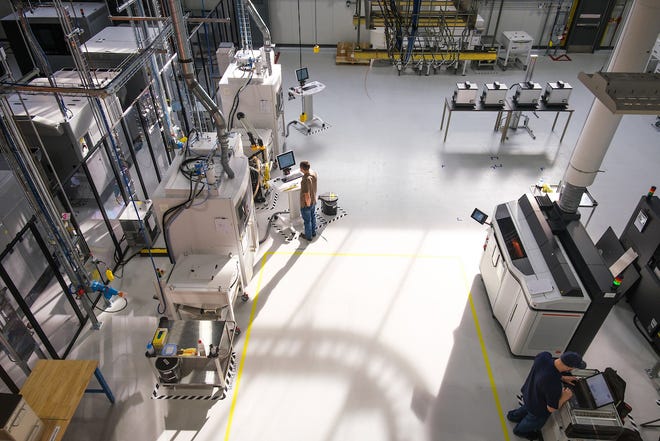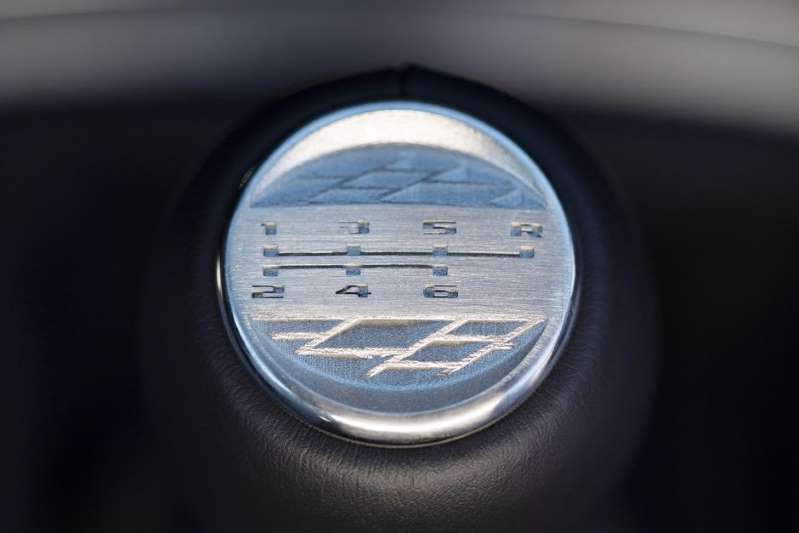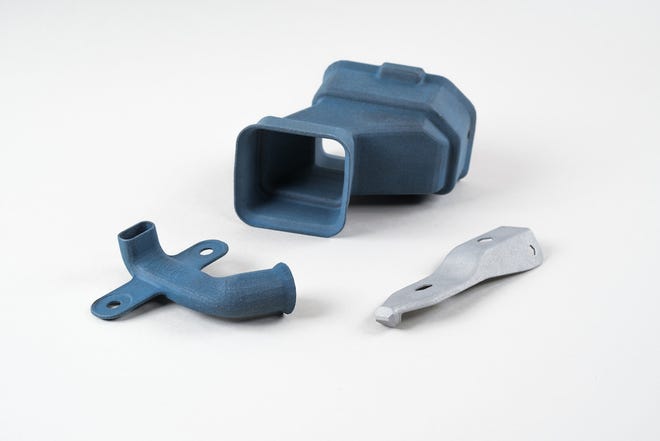In what is a serious commitment to 3D printing, General Motors (GM) has announced the opening of a 15,000-square-foot facility dedicated to making the technology production-ready for the automotive industry. The Additive Industrialization Center (AIC) represents the culmination in the auto company’s work with the technology over the last several years.
The AIC houses 24 3D printers, including metal and polymer systems such as selective laser sintering, metal laser powder bed fusion, Multi Jet Fusion, and fused deposition modeling. The site will use the technology not just for prototyping and tooling, but for end part production as well. Already many GM parts are made using functional prototypes, with early integration vehicles and test benches often relying on 3D printed parts.
Naturally, 3D printing of functional prototypes cuts overall manufacturing costs, with the ability to quickly iterate designs ultimately preventing the need to make changes later on, when modifying tooling may be more expensive. It also shrinks overall development times. In the case of brake cooling ducts developed for the Chevrolet Corvette, 3D printed prototypes shaved nine weeks and 60 percent in costs off the total development process.
3D printed tools, too, can speed up production and reduce costs. Tooling can be consolidated down from many parts to single, optimized devices that are lighter and more ergonomic. As an example, GM pointed out that almost 100 hand tools were 3D printed for the company’s latest SUVs. While these parts would have traditionally weighed in at 10 to 40 pounds of aluminum, 3D printed nylon carbon fiber composites were only three pounds and required almost no lead time for design changes.
“3D printing the body shop tools at Arlington saved more than two months in tooling construction,” Ron Daul, GM director of Additive Manufacturing and Polymer Centers, said. “This is at the critical time when we are changing the plant over to launch the new models. Ultimately, 3D printing helps accelerate new vehicle launches like our full-size SUVs.”
The latest success story in production has to do with the newest CT4-V Blackwing and CT5-V Blackwing vehicles from Cadillac. These high-end sedans will be the first GM production vehicles to include 3D printed parts: an emblem on the stick shift, an electrical harness bracket and two HVAC ducts. The company claims that the use of 3D printing will reduce costs and improve efficiency for the development of the vehicles’ manual transmissions.
“The parts printed for the Cadillac V-Series models exemplify how we can use additive applications in the right place on the right program,” said Brown. “And, this is just the beginning. Ultimately, we see the potential for 3D-printed parts to be used in a wide variety of production applications – from greater personalization options for new-vehicle buyers, to unique accessories and reproductions of classic car parts.”
As the largest auto manufacturer in the U.S. and one of the biggest in the world, GM’s investment into the center is no insignificant milestone. In 2019, the multinational had a revenue of $137.2 billion, generated from its four core brands—Chevrolet, Buick, GMC, and Cadillac—as well as the large stake it holds in foreign brands, such as Holden, Wuling, Baojun, and Jiefang. It sold 10 million vehicles in 2016 alone.
The group’s oversized influence obviously extends beyond the 3D printing industry, since it was alleged to have participated in the dismantling of the streetcar system in the early part of the 20th century to attacks on Ralph Nader’s attempts to improve vehicle safety in the ‘60s. In fact, the significance of GM was deemed so large that the U.S. government more or less or nearly nationalized it in 2009 after the economic collapse.
Despite an ignition switch fiasco that killed over a hundred people and led to massive vehicle recalls, the company seems to have regained traction in the market, in part due to Chevy’s ability to reduce the cost of its electric cars while still selling its large trucks and SUVs. The group is obviously attempting to have its cake and eat it too in selling large gasoline vehicles with one hand and electric vehicles with the other, but it at least took the side of the environment in a recent pollution battle with President Trump.
An embrace of 3D printing will play a role in the company’s manufacturing process as it moves forward. The new site is meant to be key to an agile manufacturing strategy. The company was able to demonstrate this when it was given a contract to make ventilator parts using its 3D printing technology.
“The core component of GM’s transformation is becoming a more agile, innovative company, and 3D printing will play a critical role in that mission,” said Audley Brown, GM director of Additive Design and Materials Engineering. “Compared to traditional processes, 3D printing can produce parts in a matter of days versus weeks or months at a significantly lower cost.”
If General Motors throws enough of its weight behind 3D printing, we may see the technology become adopted even more quickly in the automotive sector and beyond. In turn, there’s a possibility that airless tires and other innovations could make it to market.
Subscribe to Our Email Newsletter
Stay up-to-date on all the latest news from the 3D printing industry and receive information and offers from third party vendors.
You May Also Like
Further Understanding of 3D Printing Design at ADDITIV Design World
ADDITIV is back once again! This time, the virtual platform for additive manufacturing will be holding the first-ever edition of ADDITIV Design World on May 23rd from 9:00 AM –...
3D Printer Maker EVO-tech Reborn as NEVO3D — Once More With Feeling
EVO-tech was a 3D printing service and original equipment manufacturer established in 2013 and based in Schörfling am Attersee, Austria. The company produced high-quality material extrusion systems featuring linear bearings,...
3D Systems Brings 3D Printed PEEK Cranial Implant to the U.S. with FDA Clearance
For more than 10 years, 3D Systems (NYSE:DDD) has worked hand-in-hand with surgeons to plan over 150,000 patient-specific cases, and develop more than two million instruments and implants from its...
CDFAM Returns to Berlin for Second Annual Symposium
The second CDFAM Computational Design Symposium is scheduled for May 7-8, 2024, in Berlin, and will convene leading experts in computational design across all scales. Building upon the first event...


































